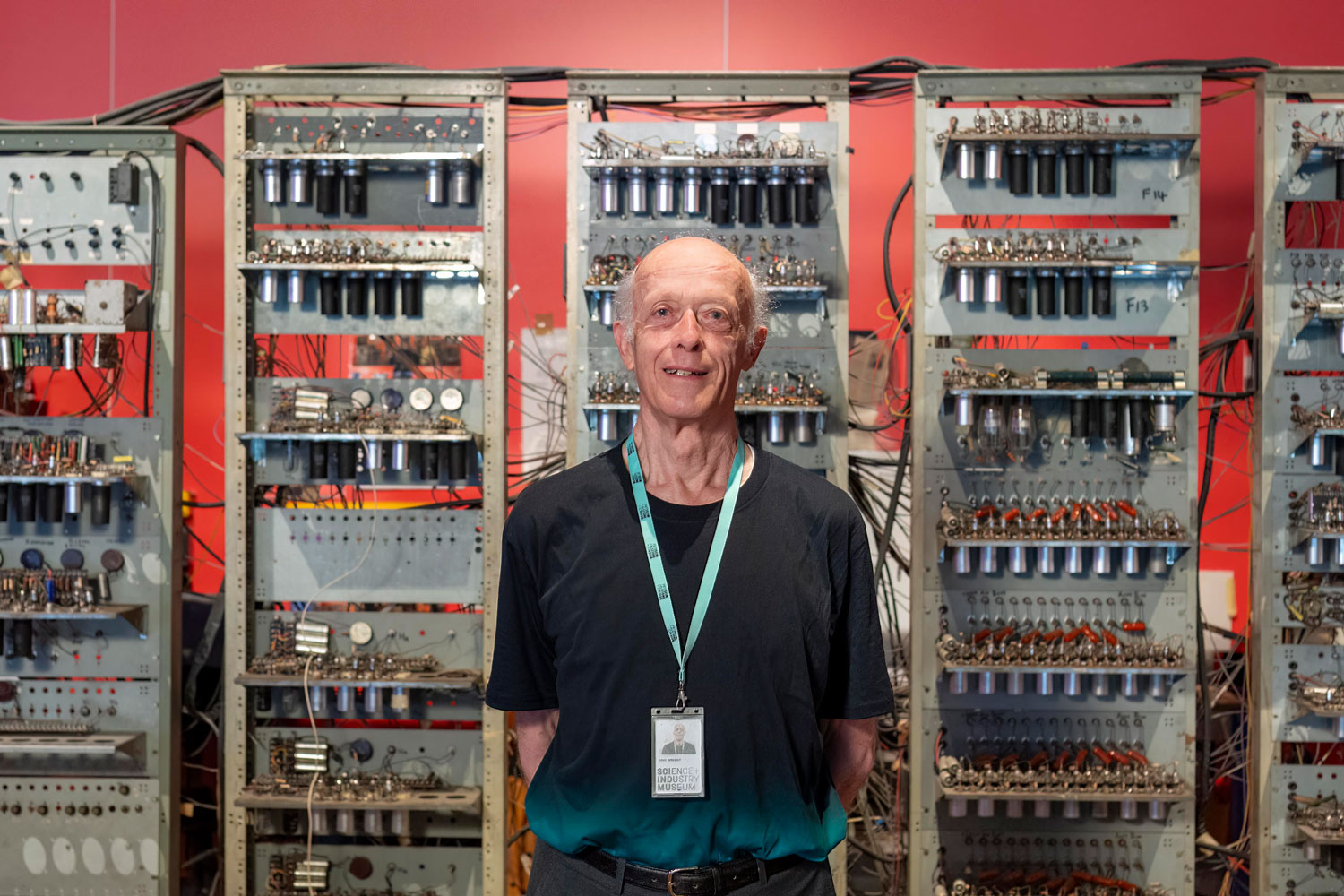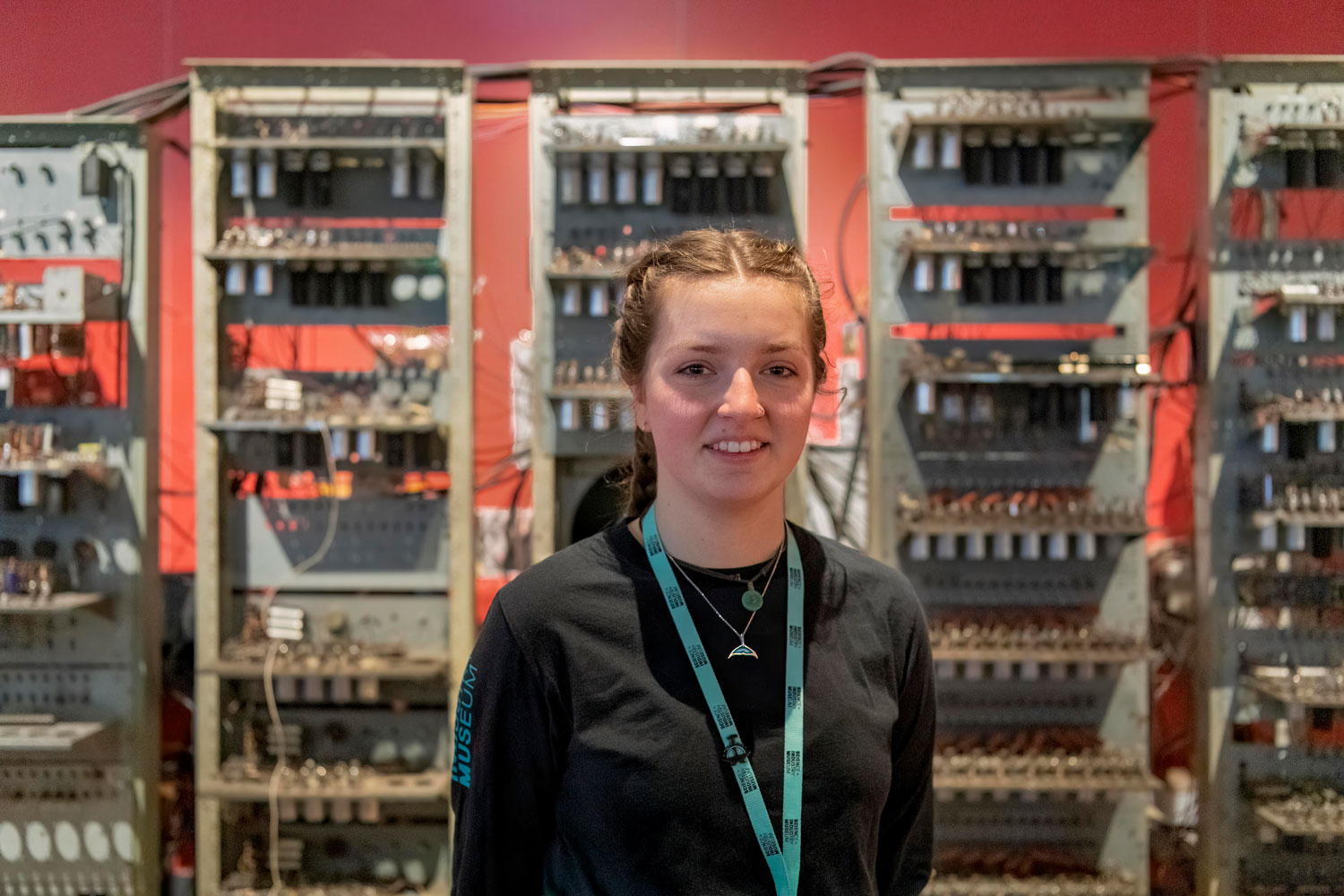In June 1948, the original Baby became the first stored program computer, meaning it was the first machine to work like the computers on our desks today.
Eric and Kira belong to a team of dedicated volunteers who work with the Science and Industry Museum’s full-scale working replica of Baby. While their 50-year age gap has given them drastically different experiences of the digital world, they have both found a shared admiration of Baby. Here, they discuss their time volunteering and how the technology, which kick-started a revolution in modern day computing 75 years ago, is still important today.
75 years ago, on 21 June 1948, a computer ran a program from memory for the very first time. In that moment, the Manchester Small-Scale Experimental Machine (Baby) made history. The machine went on to change the world, having sparked the start of the modern computer age, and it all happened right here in Manchester.
Baby was developed and built at the University of Manchester. Sir Freddie Williams and his team, including Tom Kilburn and Geoff Tootill, relocated to the city to work for the university following their top-secret work developing radar during the Second World War. The team developed a way to store computer data electronically using a cathode-ray tube, a type of electronic component more commonly used to display television pictures, later named the Williams-Kilburn Tube. To test that their new computer memory worked, they built a small experimental computer—the Manchester Baby—and then, as Freddie Williams said years later, ‘nothing was ever the same again’.
Baby was a world first and proved the basic concept that our computers still rely on today. Amongst its earliest users was the famous mathematician Alan Turing. The Williams-Kilburn Tube was the world’s first electronic computer memory and was used in several other pioneering computer projects—it is the ancestor of the RAM chips in our computers today.
At the Science and Industry Museum, we’re proud to have our own working replica of Baby, built in 1998 using vintage electronic components and with guidance from the original designers. The original no longer exists, having been taken apart for different elements to be used in later computers, so this is the closest people can get to an important piece of computing history, which took place right here in Manchester. Visitors to the museum can see regular demonstrations of the computer in use, run by a team of dedicated volunteers. There are few other places in the whole world where people can see a working first generation computer.

Science Museum Group © The Board of Trustees of the Science Museum
Eric has been a Baby volunteer for the past five years. He was just four years old when the original Manchester Small-Scale Experimental Machine first ran, so has grown up witnessing huge advances in modern-day computing and the expansion of digital technology. As a child he developed an interest in electronics, later moving to Manchester to study the subject at the University of Manchester before embarking on a career as an electronic engineer.
His work took him around the world, but he came back to the UK for his final full-time employment role as a Project Engineer, re-signalling the Victoria Line for the London Underground. Eric decided to retire in Manchester because the city had ‘given [him] such a good start in life’ and in 2018 began to volunteer at the Science and Industry Museum.

Science Museum Group © The Board of Trustees of the Science Museum
Kira, on the other hand, was born straight into the digital age. She is one of the newest Baby volunteers, joining the team just over two months ago. She too is a student at the University of Manchester, but is studying for a degree in Geology. When Kira found out about the opportunity to volunteer with Baby, she jumped at the chance to do something different from her normal focus on rocks and natural sciences. ‘It’s something new, something interesting that I thought would nicely complement my studies’, Kira said.
Surprising links
Eric had his first brush with Baby whilst studying at the University of Manchester in the 1960s, but it was over 50 years later that he realised the connection. Amongst the lecturers on his Physics and Electronics course were Sir Freddie Williams and Tom Kilburn, both key figures in the creation of the Manchester Small-Scale Experimental Machine, having led the team that developed the original Baby back in 1948.
Eric greatly admired the pair, particularly Tom Kilburn. ‘I looked upon him as an idol because his knowledge of electronics was phenomenal, and I thought if I can get 10% as far as that I’ve not done bad’, Eric said. But despite the impressive achievements of his tutors, surprisingly, they never brought up their involvement with Baby to their students. ‘The closest it came to being mentioned was when Kilburn casually raised in a class that Williams had invented a cathode ray tube [an early form of computer memory]. But I never heard either one speak directly about their own work or reference the namesake Williams-Kilburn tube specifically.’
Cue Eric’s surprise when, after arriving back in Manchester 50 years later, he discovered he was working with a replica of a machine developed by his old teachers. ‘All the circuits remind me of my university notes, so I immediately knew how everything worked, something that comes in handy when talking to visitors’, Eric says. ‘It’s wonderful to be able to give people a history of electronics that’s happened in my lifetime and explain it from the bottom up.’
While Kira doesn’t have the same lifetime links to Baby, since joining the museum her knowledge about the history and workings of the machine has grown. Supported by a team of experienced volunteers, she has discovered a new-found enthusiasm for the history of computing. ‘You pick it up fairly fast. Everything is so visual, all the parts are exposed and you can see everything that’s there, which helps you to understand how it all works together to run.’
The impact of Baby
But why is Baby still relevant today? As Eric says, ‘everything has to start somewhere’, whether that’s early planes, automobiles or computers. From school children to professors, the impact Baby has on visitors is obvious, filling them with excitement when they discover they’re standing in the city where the digital revolution began.
Baby accelerated the changes that came about in the world of computing after 1948. ‘Three years after Baby first ran a program, you could go and buy a computer! The Ferranti Mark 1 computer was commercially available’, Kira says excitedly—it’s a fact she delights in telling visitors, particularly school children, who have grown up with computers being commonplace in their homes and hands. ‘There has been a dramatic change in size over the years though,’ Kira admits. ‘Baby is over five metres long, compared to today’s computers that you can hold in your hand. The change in power is amazing too, the very first iPads were around 10,000 times faster than Baby!’
Eric likes to use the analogy of a person losing their memory to explain what a huge step forward Baby’s ability to store and run a program from memory was for computing. ‘I always start by asking visitors, before we go any further, what would you be able to do if you’d got no memory? Not a lot? And I say a computer’s the same, if it has no memory it can’t do anything. Having the memory to store a program meant that Baby was able to carry out multiple tasks on command, the first step towards today’s computers.’
Baby has undoubtedly changed the world, providing the basic blueprint still used in billions of computers. On a personal note, however, it is continuing to provide both Eric and Kira, as well as the hundreds of thousands of people who visit the Science and Industry Museum, with inspirational experiences.
Through her work with Baby, Kira feels part of a wider community, inside and outside the museum. ‘I feel more part of Manchester, getting on my bike, cycling in and coming to the museum, it feels like I get more involved with the community. And of course I’m getting to talk about a big part of the city’s history and identity.’ She’ll be returning to volunteer with Baby in the new academic year.
Eric enjoys the chance to share his knowledge with so many people from different backgrounds. He talks to visitors from around the world, often drawing on experiences from his time working abroad. He’s also a keen advocate for museums: ‘It’s only in a museum that people can really understand how it all began, where they can see the machine for themselves and get a sense of scale”.
As he likes to put it, ‘knowledge is to be shared, not to be locked away’.
Find out more about Baby here. Catch regular demonstrations from our Baby volunteers in the Revolution Manchester gallery and discover more about the history of this amazing machine in our Objects and Stories section.